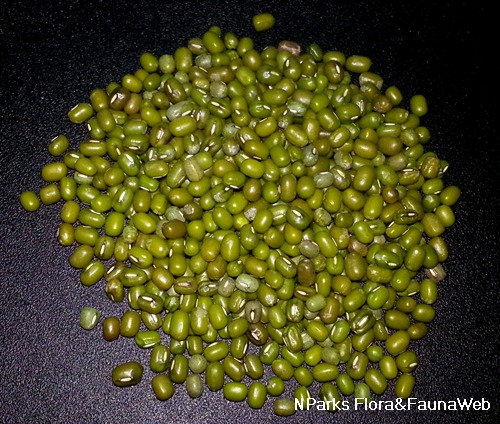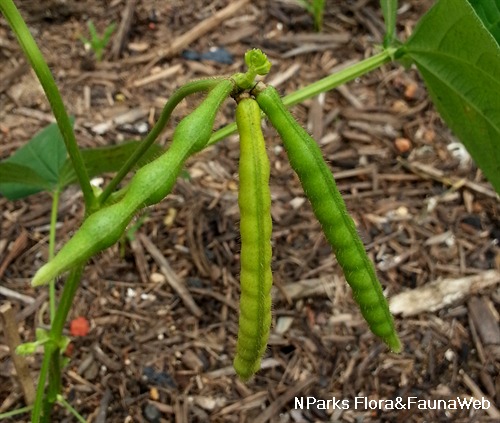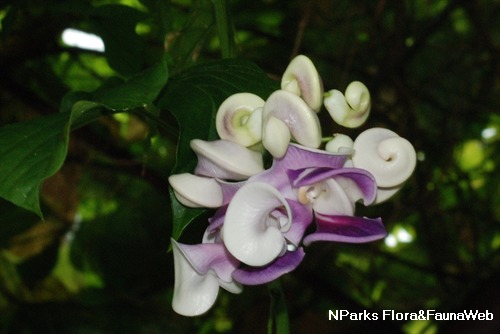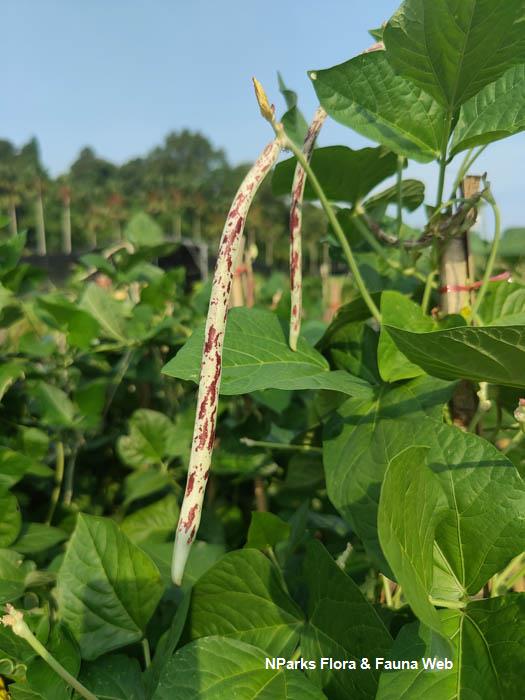
Back
Vigna radiata (L.) R.Wilczek
| Family Name: | Fabaceae (Leguminosae) |
| Synonyms: | Phaseolus aureus |
| Common Name: | Mung bean, Green gram, Green bean, 绿豆 |
Name
Classifications and Characteristics
| Plant Division | Angiosperms (Flowering Seed Plants) (Dicotyledon) |
|---|---|
| Plant Growth Form | Creeper |
| Lifespan (in Singapore) | Annual |
Biogeography
| Native Distribution | India |
|---|---|
| Native Habitat | Terrestrial |
| Preferred Climate Zone | Tropical |
Description and Ethnobotany
| Foliage | Alternate arrangement, 3 foliolate (sometimes 5 foliolate), dark green; stipules ovate, 0.8-1.2cm, leaflet elliptic/ovate, 5-16cm long, 3-12cm broad; petiole 5-21cm long, rachis 1.5-4.5cm long; glabrous or bristly pilose(soft long hairs) on both surfaces. |
|---|---|
| Stems | Erect, twining or creeping, angular, covered with long spreading hairs. |
| Fruit | Linear cylindrical pod, 4-9cm long, 0.5-0.6cm broad, pubescent, hairs spreading, dark brown, 8-14 seeded. |
| Ethnobotanical Uses | Edible Plant Parts : Edible Seeds Food (Fruit or Vegetable): Bean sprouts (豆芽) are eaten raw or cooked most Asian countries. Mung bean sprouts are stir-fried as Chinese vegetable accompaniment to a meal. Raw bean sprouts are used in filling for Vietnamese spring rolls. The starch extracted from mung beans is used in making noodles and jellies. They are also used in making desserts and soups. Medicinal: The seeds are edible and are used medicinally. Mung beans have high protein and fiber content that yield complex carbohydrates, which help in digestion and bring down the cholesterol level in the body. According to Chinese medicine, the sprouts are considered as a cooling food with anti-cancerous properties. |
Landscaping Features
| Landscape Uses | General, Interiorscape/ Indoor Plant, Container Planting |
|---|---|
| Thematic Landscaping | Economic Garden |
Plant Care and Propagation
| Light Preference | Full Sun |
|---|---|
| Water Preference | Moderate Water |
| Plant Growth Rate | Fast |
| Rootzone Tolerance | Moist Soils, Well-Drained Soils, Fertile Loamy Soils |
| Propagation Method | Seed |
Foliar
| Foliage Retention | Evergreen |
|---|---|
| Mature Foliage Colour(s) | Green |
| Mature Foliage Texture(s) | Hairy / Hirsute |
| Foliar Modification | Stipule |
| Foliar Type | Compound (Trifoliate) |
| Foliar Arrangement Along Stem | Alternate |
| Foliar Attachment to Stem | Petiolate |
Floral (Angiosperm)
| Flower & Plant Sexuality | Bisexual Flowers |
| Flower Colour(s) | Yellow / Golden |
|---|---|
| Flower Grouping | Solitary |
| Flower Location | Axillary |
Fruit, Seed and Spore
| Mature Fruit Colour(s) | Black, Brown |
|---|---|
| Mature Seed Colour(s) | Green |
| Mature Seed Texture(s) | Smooth |
| Seed Quantity Per Fruit | Several (11-20) |
Image Repository
Others
| Master ID | 31491 |
|---|---|
| Species ID | 5888 |
| Flora Disclaimer | The information in this website has been compiled from reliable sources, such as reference works on medicinal plants. It is not a substitute for medical advice or treatment and NParks does not purport to provide any medical advice. Readers should always consult his/her physician before using or consuming a plant for medicinal purposes. |

.jpg)
.jpg)
.jpg)
.jpg)






